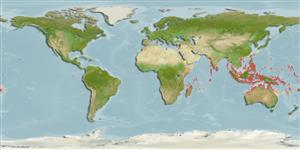Common names from other countries
>
Kurtiformes (Nurseryfishes, cardinalfishes.) >
Apogonidae (Cardinalfishes) > Apogoninae
Etymology: Sphaeramia: Greek, sphaira = ball + Greek, amia = a kind of shark (Ref. 45335).
More on author: Cuvier.
Environment: milieu / climate zone / depth range / distribution range
Ecologie
marien rifbewoner; diepte 0 - 5 m (Ref. 9710). Tropical; 31°N - 27°S, 32°E - 173°W
Indo-Pacific: East Africa to Kiribati, north to the Ryukyu Islands, south to New Caledonia; Belau to eastern Caroline and Mariana Islands in Micronesia.
Lengte bij maturiteit / Grootte / Gewicht / Leeftijd
Maturity: Lm ?, range 6 - ? cm
Max length : 10.0 cm TL mannelijk / geslacht onbekend; (Ref. 4329); common length : 8.9 cm SL mannelijk / geslacht onbekend; (Ref. 37816)
Dorsale stekels (totaal) : 8; Dorsale zachte stralen (totaal) : 9; Anale stekels: 2; Anale zachte stralen: 9. Greenish grey, with dark vertical bar from origin of spiny dorsal to just in front of anus; scattered spots on body, head and 1st dorsal membrane; pelvic fins dark (Ref. 4329, 48635).
Restricted to coastal waters, forming small aggregations among mangroves, rocks, debris, or piers of shallow sheltered shorelines. Feeds at night (early evening and just before day break), primarily on planktonic crustaceans. Courtship and spawning occur fortnightly (shortly before new moons and full moons). Eggs are incubated by the male for about 8 days. Larval phase pelagic. Sexual maturity is attained at 7 cm by males and at 6 cm by females (Ref. 1602).
Courtship and spawning occur on a semi-lunar cycle, shortly before full and new moons (Ref. 37816). Distinct pairing during courtship and spawning (Ref. 205). Are mouthbrooders (Ref. 240). Males incubate up to 12,000 eggs for a period of about 8 days (Ref. 37816). After the pelagic larval phase, juveniles settle and grow at a rate of 3 to 6 mm per month (Ref. 37816).
Gon, O., 1986. Apogonidae. p. 546-561. In M.M. Smith and P.C. Heemstra (eds.) Smiths' sea fishes. Springer-Verlag, Berlin. (Ref. 4329)
Status op de Rode Lijst van het IUCN (Ref. 130435)
CITES (Ref. 128078)
Not Evaluated
Gevaar voor de mens
Harmless
Gebruik door de mens
Visserij: van minder commercieel belang
Tools
Speciale rapporten
Download XML
Internetbronnen
Estimates based on models
Preferred temperature (Ref.
115969): 26.3 - 29.3, mean 28.6 (based on 2452 cells).
Fylogenetische diversiteitsindex (Ref.
82804): PD
50 = 0.7500 [Uniqueness, from 0.5 = low to 2.0 = high].
Bayesian length-weight: a=0.02138 (0.01194 - 0.03827), b=3.07 (2.91 - 3.23), in cm Total Length, based on LWR estimates for this species & (Sub)family-body (Ref.
93245).
Trofisch niveau (Ref.
69278): 3.6 ±0.51 se; based on food items.
Weerstandsvermogen (Ref.
120179): Hoog, minimale populatieverdubbelingstijd minder dan 15 maanden (Preliminary K or Fecundity.).
Fishing Vulnerability (Ref.
59153): Low vulnerability (10 of 100).
